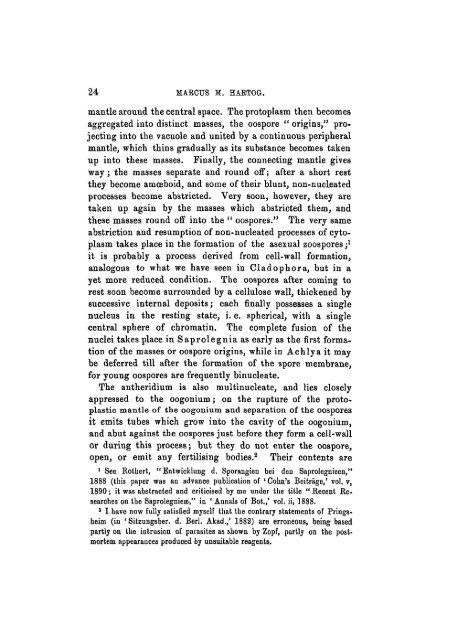Some Problems of Reproduction: a Comparative Study of ...
Some Problems of Reproduction: a Comparative Study of ...
Some Problems of Reproduction: a Comparative Study of ...
Create successful ePaper yourself
Turn your PDF publications into a flip-book with our unique Google optimized e-Paper software.
24 MARCUS M. HARTOG.<br />
mantle around the central space. The protoplasm then becomes<br />
aggregated into distinct masses, the oospore " origins/' projecting<br />
into the vacuole and united by a continuous peripheral<br />
mantle, which thins gradually as its substance becomes taken<br />
up into these masses. Finally, the connecting mantle gives<br />
way; the masses separate and round <strong>of</strong>f; after a short rest<br />
they become amoeboid, and some <strong>of</strong> their blunt, non-nucleated<br />
processes become abstricted. Very soon, however, they are<br />
taken up again by the masses which abstricted them, and<br />
these masses round <strong>of</strong>f into the " oospores." The very same<br />
abstriction and resumption <strong>of</strong> non-nucleated processes <strong>of</strong> cytoplasm<br />
takes place in the formation <strong>of</strong> the asexual zoospores ; x<br />
it is probably a process derived from cell-wall formation,<br />
analogous to what we have seen in Cladophora, but in a<br />
yet more reduced condition. The oospores after coming to<br />
rest soon become surrounded by a cellulose wall, thickened by<br />
successive internal deposits; each finally possesses a single<br />
nucleus in the resting state, i. e. spherical, with a single<br />
central sphere <strong>of</strong> chromatin. The complete fusion <strong>of</strong> the<br />
nuclei takes place in Saprolegnia as early as the first formation<br />
<strong>of</strong> the masses or oospore origins, while in Achlya it may<br />
be deferred till after the formation <strong>of</strong> the spore membrane,<br />
for young oospores are frequently binucleate.<br />
The antheridiutn is also multinucleate, and lies closely<br />
appressed to the oogonium; on the rupture <strong>of</strong> the protoplastic<br />
mantle <strong>of</strong> the oogonium and separation <strong>of</strong> the oospores<br />
it emits tubes which grow into the cavity <strong>of</strong> the oogonium,<br />
and abut against the oospores just before they form a cell-wall<br />
or during this process; but they do not enter the oospore,<br />
open, or emit any fertilising bodies. 3 Their contents are<br />
1 See Rothert, "Entwioklung d. Sporangien bei den Saprolegnieen,"<br />
1888 (this paper was an advance publication <strong>of</strong> ' Cohn's Beitrage,' vol. v,<br />
1890; it was abstracted and criticised by me under the title " Recent Researches<br />
on the Saprolegniese," in ' Annals <strong>of</strong> Bot.,' vol. ii, 1888.<br />
3 I have now fully satisfied myself that the contrary statements <strong>of</strong> Pringsheim<br />
(in ' Sitzungsber. d. Berl. Akad.,' 1882) are erroneous, being based<br />
partly on the intrusion <strong>of</strong> parasites as shown by Zopf, partly on the postmortem<br />
appearances produced by unsuitable reagents.

















